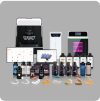
How 3D Printing Is Improving the Footwear Manufacturing Process

Traditional footwear manufacturing is a time-consuming process that often limits designs. With high tooling costs and production limitations, initial designs, tooling, and prototyping can take months to complete and require significant investments. The final product design must fit the production method, and processes, like injection molding, can constrain the design. Products need to be developed so that tools can be built for mass production. Designers who work with injection molding must often reconfigure their product layouts to meet production criteria after the prototyping stage.
In recent years, footwear manufacturers have incorporated 3D printing technology into existing processes with great success. Experts predict the upward trend will only grow in the coming decade. The forecasted expansion credits 3D printing’s impact on speed-to-market, product variation, customization possibilities, durability, and design freedom. By the end of 2030, the total revenue associated with 3D-printed footwear is expected to top $9 billion—a substantial increase from the 2020s projected revenue of $1.4 billion.
The Manufacturing Benefits of 3D-Printing Footwear
3D printing enables footwear manufacturers to avoid issues that slow progress and that constrain designs. 3D printers use a digital process that eliminates tooling, accelerates time between production phases, and expands customization possibilities. Companies that incorporate 3D printing into footwear manufacturing processes have three main advantages:
#1 Accelerate Speed-to-Market
Shoe developers who leverage 3D printing can introduce new products to the market in a fraction of the time compared to traditional manufacturing. Increased speed comes from two factors: a streamlined innovation cycle and on-demand production.
- Streamlined Innovation Cycle: 3D printing enables designers to create more prototype iterations per batch than conventional methods like injection molding. Designs can quickly go from sketch to production-ready using a CAD file. Eliminating molds and costs/time associated with tooling allows multiple design variations per run. Manufacturers can test for numerous characteristics in a single batch, resulting in a quicker determination of the final design. 3D printing’s capability to create fully-functional prototypes further streamlines the process, and experimental models can immediately be field-tested.
- On-Demand Production: Facilities that use conventional production processes require multiple time-consuming steps to create a market-ready product. Final designs must conform to production specifications, require molds to be made, and have high MOQs that must be met. Companies can avoid or minimize these requirements by partnering with a 3D printing smart factory. Smart factories offer the following services:
- Cloud 3D Printing Production: Cloud 3D printers use the same processes to create prototypes as final products. If a company designs a product using the same software as the smart factory, they can immediately scale. The company digitally sends the CAD file over to the factory, and production can begin.
- Smart Factory Commercialization Services: Companies that do not have a cloud 3D printer can also work with a smart factory to optimize designs and begin production. The CAD file is sent to the factory via the cloud, where techs ensure the product is printable and that all mechanical, aesthetic, and business goals (e.g., cost and turnaround time) are met before production starts.
Even with the best conditions, traditional production methods bring new footwear to the market in a little over a year. With 3D printing technology, new market-ready footwear is produced in months.
#2 Increase Product Variation
The tooling process for injection molding is long, and molds constrain manufacturers from making design alterations. If market feedback requires product redesign, ultimately, new molds are needed. New molds are both expensive and time-consuming to create—often hindering companies from responding to customer demands.
Companies can leverage 3D printing’s tooling-free operation to make design changes at a far quicker pace. Designers simply make adjustments to the product’s CAD file, send the new file to the smart factory, and use on-demand printing to capitalize on market opportunities.
Designers can also take advantage of versatile capabilities to create low-volume production runs of experimental variants. Smart factories’ lower MOQs, allowing shoe companies to make small batches to gain market feedback quickly. Companies can make informed decisions about which editions to produce at a higher-volume based on market feedback or reaction.
#3 Customization Possibilities
The cost and production limitations of injection molding make it incompatible with creating individualized products. As a result, customized footwear has largely been an artisanal process. 3D printing streamlines the custom footwear process using digital scans and versatile materials, creating products faster, more efficiently, and economically.
3D printing is making an impact and improving the production of marathon running shoes and orthotics:
- Marathon Running Shoes: 3D printers allow companies to create shoes perfectly crafted to fit the owner’s feet. Custom elements like product weight, fit, wall thickness, and material flexibility can all be designed to the customer’s exact specifications, allowing them to achieve optimal results on the track. Customers can also personalize aesthetic choices, such as structure, graphics, texture, and color. The polyurethane material used to create 3D-printed shoes are far more durable than the closed-cell foam used in injection molding. Some 3D-printed shoes have lasted two-to-three times longer than their foam counterparts.
- Orthotics: Traditional production of orthotics is labor-intensive and slow-moving. A professional crafts the products by hand from multiple materials so that the insole perfectly adapts to a patient’s feet. 3D printing makes production completely digital by using scans of the client’s feet to build a highly accurate model and converting it to a.STL file with stiffness and geometry specified based on the podiatrist’s clinical assessment. The custom orthotic is printed using a single elastic resin with hardness/rigidity freely adjusted using geometry—eliminating the need for multiple material types. The final orthotics reliably fit a patients’ feet, are produced with a more straightforward and cost-effective process, and provide greater comfort and support to the consumer.
#4 Localized Manufacturing
Additive manufacturing allows for more localized production than traditional manufacturing. Mass production with traditional methods is generally centralized in overseas factories. Companies predict demand for their products years ahead of release and hope that it aligns with consumer orders. The outsourcing model opens companies up to the risk of either not sufficiently meeting demand or over-producing an unpopular product.
With 3D printing, instead of using a single outsourced facility to create products, manufacturers can use multiple smaller smart factories closer to the target market. The closer proximity enables more agile responses to local market demands such as product volume, design, and customization/personalization.
Accelerating production speed is further enabled by simplified product designs made possible by 3D printing. Conventionally-produced footwear is made of multiple smaller parts (e.g., midsole, outsole, uppers, etc.) that are then glued and stitched together in an assembly line. 3D printers allow designers to consolidate parts and specific assembly steps—expediting the production process.
3D Printing’s Versatility Improves the Footwear Manufacturing Process
3D printing is allowing footwear companies to explore more production possibilities than ever before. Fully functional prototyping capabilities of 3D printers enable companies to move through an innovation cycle much faster than traditional methods, and on-demand printing makes production instantly scalable. Designers can easily adjust CAD files to align product variants with market demands. Manufacturers can also mix 3D-printed parts with traditional shoe components or 3D-print entire shoes, opening new avenues for customization in traditionally artisanal products.
Shoe manufacturers can continue to enhance the footwear production process with 3D printing. Whether the goal is to speed time to market, improve variation, customization, or design freedom, a 3D printing solution can help companies accomplish it.
For more information on how LuxCreo’s services can improve your footwear manufacturing processes, visit our contact page or call (650) 336-0888.
Subscribe to Our Newsletter
Be the first to get our latest updates and free trials!
Popular Resources
Follow Us
Featured Products

4D Aligner™
First Smart ActiveMemory™
Aligner

iLux Pro Dental Solution
Ultimate 1-Click Dental
Application Solution

LuxCloud Dental
Your One-stop Digital Dentistry
Platform





